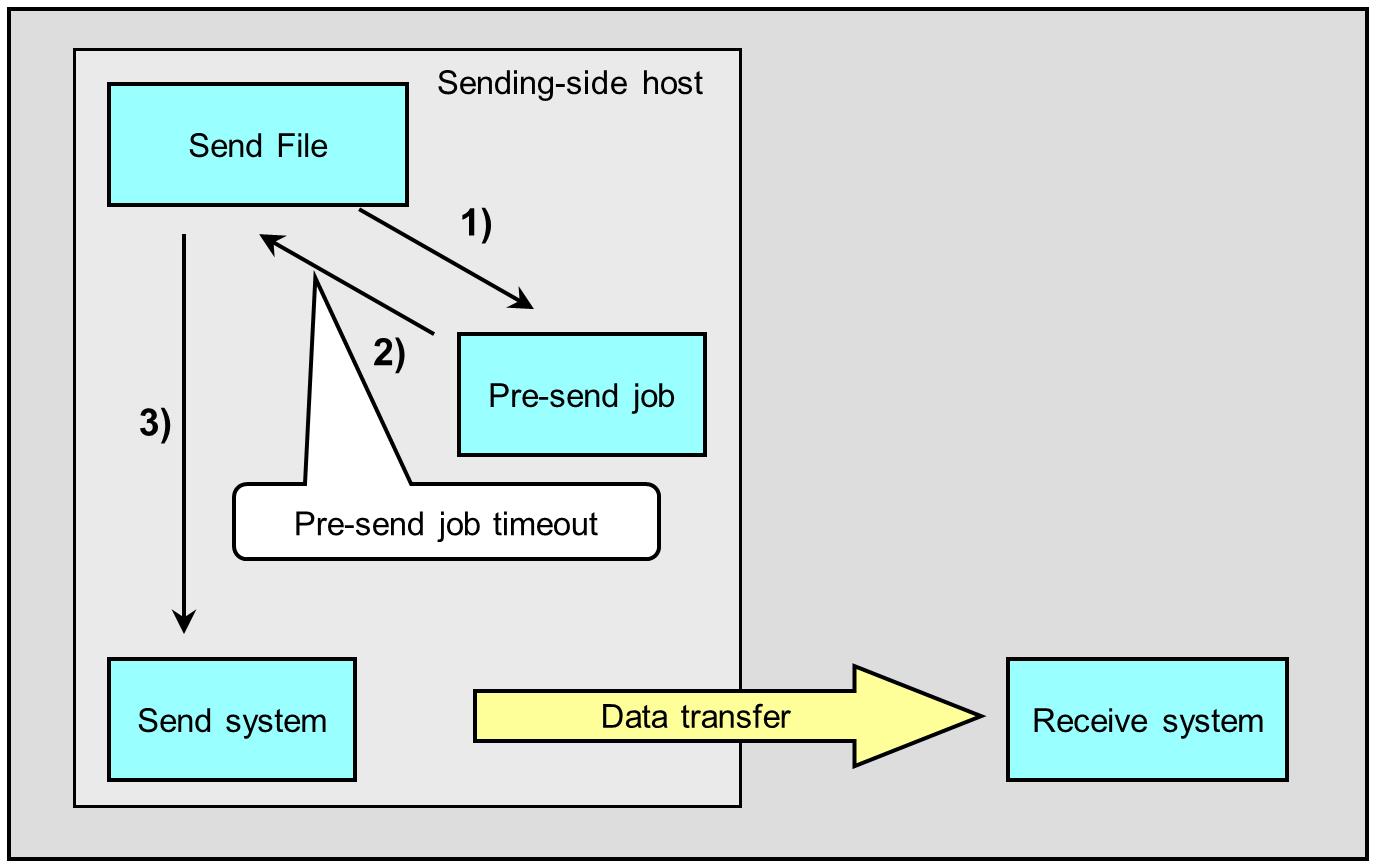Pre-send job timeout
For pre-send jobs, the program to execute the job specified as the pre-send job differs depending on the method of issuing the request. Therefore, the value used for detecting the timeout may also differs. There are two major patterns as shown below:
-
When you issue the Send File request by using the Send File Issuance command or on the HULFT Management Console
-
When you issue the Send Request request or when you execute the Send File Issuance command via HULFT Manager
(1) When you issue the Send File request by using the Send File Issuance command or on the HULFT Management Console
When you issue the Send File request by using the Send File Issuance command or on HULFT Management Console, the request is issued on the sending-side host. The explanation on such case is provided below:

Figure 4.2 Pre-send job timeout (for an example of sending-side transferring initiated by Send File Issuance command)
1) When the Send File Issuance command is executed, HULFT starts the user job specified as the pre-send job.
The Send File Issuance command does not do anything and remains in the waiting status until the pre-send job is complete.
3) After confirming that the job has successfully ended, the Send File Issuance command issues a request to the Send system to start the file transfer.
However, if the timeout value for waiting for the result of the pre-send job set in 2) is not long enough, the Send File Issuance command may be terminated due to the timeout.
In HULFT for Mainframe, HULFT continues executing the job, while in HULFT for IBMi, HULFT for UNIX/Linux, HULFT for NSK, and HULFT for Windows, it forcibly terminates the job when the timeout is reached.
Specify the timeout for the job shown as 2) in the above figure as Job Timeout.
<How to specify the settings>
In HULFT for Mainframe
- For the Send File Issuance program
-
In XRSYSIN definition card for the startup JCL of the Send File program (XRSNDGO):
-
JOBTIME= job timeout for pre-send job (minutes)
-
- For Send File issued from the HULFT Management Console
-
In the command procedure or XRSYSIN definition card for the HULFT screen start-up command (HULFT):
-
JOBTIME= job timeout for pre-send job (minutes)
-
In HULFT for IBMi
- For the Send File Issuance command (UTLSEND) or Send File issued from the HULFT Management Console
-
In the System Environment Settings:
-
Job Timeout (seconds) (tag name: JOBWTIMEOUT)
-
In HULFT for UNIX/Linux or HULFT for NSK
- For the Send File Issuance command (utlsend) or Send File issued from HULFT Management Console
-
In the System Environment Settings:
-
Job Timeout (seconds) (tag name: jobwtimeout)
-
HULFT for Windows
- For the Send File Issuance command (utlsend.exe) or Send File issued from the HULFT Management Console
-
In the System Environment Settings:
-
Job Timeout (seconds) (tag name: jobwtimeout)
-
(2) When you issue the Send Request request or when you execute the Send File Issuance command via HULFT Manager
When you issue the Send Request request or when you execute the Send File Issuance command via HULFT Manager, the request is issued by the remote host and the Observe system receive the request. The explanation on such case is provided below:

Figure 4.3 Pre-send job timeout (for an example of sending-side transferring initiated by Send Request Issuance command)
1) The Send Request Issuance command is executed on the receiving side.
2) After accepting the request, the Observe system starts the user job specified as the pre-send job.
Until the pre-send job is complete, the Observe system does not do anything and remains in the waiting status.
4) After confirming that the job has successfully ended, the Observe system issues the request to the Send system to carry out the file transfer.
However, if the timeout value for waiting for the result of the pre-send job set in 3) is not long enough, the Send Request Issuance command may be terminated due to the timeout.
In the host types categorized as HULFT for Mainframe, HULFT continues executing the job, while in HULFT for IBMi, HULFT for UNIX/Linux, HULFT for NSK, and HULFT for Windows, it forcibly terminates the job when the timeout is reached.
Specify the timeout for the job shown as 3) in the above figure as Job Timeout.
<How to specify the timeout>
In HULFT for Mainframe
- For the Send Request Issuance program (XRRCVREQ), Send Request issed from the HULFT Management Concole, or Send File or Send Request issued via HULFT Manager
-
Specify the following in XRSYSIN definition card for the startup JCL of the Observe program (XRACCPT):
-
JOBTIME= job timeout for pre-send job (minutes)
-
In HULFT for IBMi
- For the Send Request Issuance command (UTLRECV), Send Request issued from the HULFT Management Console, or Send File or Send Request issued via HULFT Manager
-
Specify the following in the System Environment Settings:
-
Job Timeout (seconds) (tag name: JOBWTIMEOUT)
-
In HULFT for UNIX/Linux or HULFT for NSK
- For the Send Request Issance command (utlrecv), Send Request issued from the HULFT Management Console, Send File and Send Request issued via HULFT Manager
-
Specify the following in the System Environment Settings:
-
Job Timeout (seconds) (tag name: jobwtimeout)
-
In HULFT for Windows
- For the Send Request Issuance command (utlrecv.exe), Send Request issued from the HULFT Management Console, or Send File or Send Request issued via HULFT Manager
-
Specify the following in the System Environment Settings:
-
Job Timeout (seconds) (tag name: jobwtimeout)
-